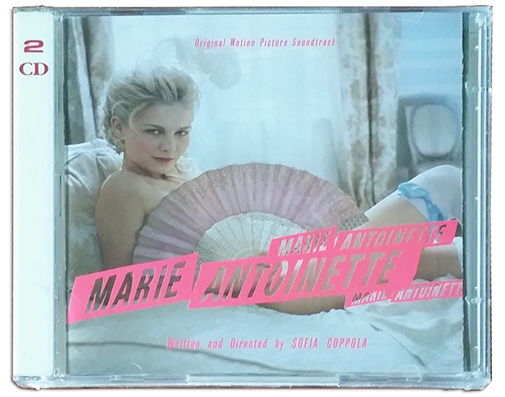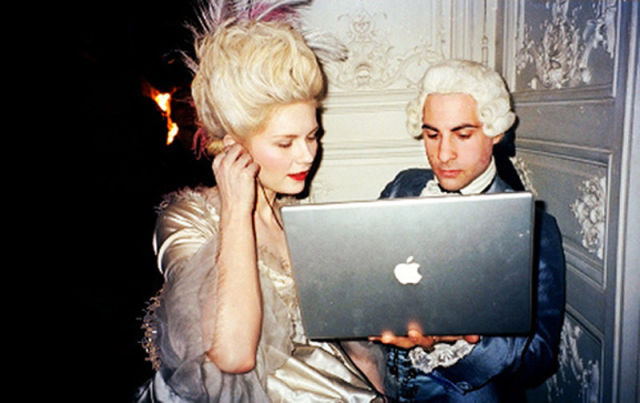Marie Antoinette Week: The Musical Stylings of Sofia Coppola's Biopic
 Thursday, October 13, 2016 at 3:00PM
Thursday, October 13, 2016 at 3:00PM Editor's Note: On this very week in 1793 the Queen Consort of France Marie Antoinette (born Maria Antonia Josepha Johanna von Habsburg-Lothringen -whew) stood "trial" and was guillotined during the French Revolution. She's haunted popular culture ever since. On this very week ten years ago in 2006, Sofia Coppola's undervalued and unconventional biopic Marie Antoinette began its trip to movie theaters. We're celebrating every day at 3 PM EST for a week. Party.
 Lynn Lee looks back at Marie Antoinette's (2006) controversial use of music...
Lynn Lee looks back at Marie Antoinette's (2006) controversial use of music...
First come the fast, bracing guitar chords, followed by the almost-too-on-point Gang of Four lyrics - “The problem of leisure, what to do for pleasure?” - as the opening credits roll in bright hot pink against a black background. We catch a quick shot of a reclining Marie Antoinette (Kirsten Dunst), tasting one of an array of sumptuous cakes as she tries on a shoe and gives a saucy sideways glance into the camera as if to say “Let me eat cake.” It’s our first tip-off that this isn’t going to be your standard historical costume drama...
At the time of its release, Sofia Coppola’s Marie Antoinette stirred some controversy with its anachronistic touches – especially its soundtrack, which flits between period-appropriate Baroque music and the punk and post-punk sounds of Bow Wow Wow, New Order, the Cure, and the Strokes, among others. Kvetching about the music folded into a larger critique that Coppola played fast and loose with historical facts, notwithstanding that the movie was filmed at Versailles and nominally based on Antonia Fraser’s sympathetic biography of the ill-fated queen. To some, Coppola trivialized historical events by framing them as yet another tale of a lost girl searching for fulfillment within an artificially confined universe.
 Dunst & Schwartzman on the set of Marie Antoinette (2006)
Dunst & Schwartzman on the set of Marie Antoinette (2006)
Not me. I love this film unreservedly and consider it Coppola’s best. It may be impressionistic rather than historically accurate, yet it’s hardly trivial or shallow in its treatment of its subject. On the contrary, it makes Marie an endearing and profoundly poignant figure, not despite but because of her total insulation from the outside world. It’s witty, even laugh-out-loud funny at times, yet surprisingly tender, especially in its depiction of her relationship with Louis XVI (Jason Schwartzman). And its mix of contemporary and period music syncs beautifully with the shifts in her moods and conception of her place in this strange soap-bubble universe.
While pensive ambient music captures Marie’s sense of isolation and disconnectedness, up-tempo New Wave songs inject jolts of energy that animate her desperate quest for amusement, whether it’s a masked ball (to the tune of Siouxsie and the Banshees’ “Hong Kong Garden”), a birthday bash that lasts till sunrise (New Order’s “Ceremony”), or an extramarital fling (Adam and the Ants’ “Kings of the Wild Frontier”). Or the sequence most viewers will probably remember best: the 18th century equivalent of a girls’ shopping spree, set to Bow Wow Wow’s “I Want Candy” and filmed as a breathless montage of pastel fabrics, shoes, champagne, and sweets. What most people might not remember is that it comes at the height of Marie’s frustration with her marriage, amid constant admonitions that she’s useless unless she gives birth to a son. What’s a girl to do with unlimited credit and no job other than to bear an heir to a husband uninterested in sex?
The rock-infused bursts of reckless self-indulgence etch a striking contrast to the rigidly formal classical compositions, which mostly serve to underscore the constraints of Marie’s official position. The latter are set off to great comedic effect early on by the stately Vivaldi concerto that accompanies the elaborate ceremony of her morning routine. But they’re also given a more serious gloss in the two Rameau operas Marie attends in Paris, at very different junctures in her royal tenure, that mark her rise and fall in the public eye. When she applauds rapturously at the first opera, the rest of the audience smiles and follows her lead, even though it’s not proper protocol; much later in the movie, when she applauds at the second opera, she draws only silence and grimly disapproving stares. It’s a sobering moment, showing how far her stock has fallen, and an omen of how much farther she will fall. It’s also another reminder that Coppola knew exactly what she was doing with every musical choice for every scene. Far from being disjointed or discordant, the eclectic, century-leaping soundtrack is a seamless part of what makes the film so memorable - and so timeless.



Reader Comments (4)
The music in the film I think worked for the most part. The scene where they played Siouxsie & the Banshees' "Hong Kong Garden" is the best example where it has this rhythmic timing that is similar to the music that was being played in those times as I realized how much sense it made. It's a very misunderstood film and the soundtrack is awesome as I still have the 2-CD set.
I felt such joy watching the I WANT CANDY video again. can't wait to rewatch this this week. It's sbeen awhile. And you're right -- i'd totally forgotten where this sequence was placed and why. such a smart film and i'm so proud we honored it in its year rather than dismissing it!
I love this movie too, and think the soundtrack completely fits the extravagant but cloistered world of 18th-century Versailles that Coppola wanted to us to see. If anything, the music helps make Antoinette's world and lifestyle more relatable to a 21st-century audience. By the end, we're completely sympathetic to the queen precisely because we see how divorced from reality she is. I'd say that's an accomplishment on Coppola's part.
I LOVE the anachronistic touches in Marie Antoinette (the contemporary music! the Converses!) and wish that more biopics would try different experimental things like this. It would make for much more interesting movies than your standard Oscar-bait biopics. I'm so glad that Coppola was willing to try this and take a risk, even if it meant that some critics would be put off by it